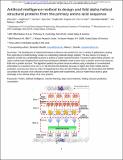Artificial intelligence method to design and fold alpha-helical structural proteins from the primary amino acid sequence
Author(s)
Qin, Zhao; Wu, Lingfei; Sun, Hui; Huo, Siyu; Ma, Tengfei; Lim, Eugene J.; Chen, Pin-Yu; Marelli, Benedetto; Buehler, Markus J; ... Show more Show less
DownloadSubmitted version (1.593Mb)
Publisher with Creative Commons License
Publisher with Creative Commons License
Creative Commons Attribution
Terms of use
Metadata
Show full item recordAbstract
The development of rational techniques to discover new mechanically relevant proteins for use in variety of applications ranging from mechanics, agriculture to biotechnology remains an outstanding nanomechanical design problem. The key barrier is to design a sequence to fold into a predictable structure to achieve a certain material function. Focused on alpha-helical proteins (as found in skin, hair, and many other mechanically relevant protein materials), we report a Multi-scale Neighborhood-based Neural Network (MNNN) model to learn how a specific amino acid sequence folds into a protein structure. The algorithm predicts the protein structure without using a template or co-evolutional information at a maximum error of 2.1 Å. We find that the prediction accuracy is higher than other models and the prediction consumes less than six orders of magnitude time than ab initio folding methods. We demonstrate that MNNN can predict the structure of an unknown protein that agrees with experiments, and our model hence shows a great advantage in the rational design of de novo proteins. Keywords: Protein; artificial intelligence; machine learning; deep neural networks; folding; structure prediction; computation
Date issued
2020-02Department
Massachusetts Institute of Technology. Department of Civil and Environmental EngineeringJournal
Extreme Mechanics Letters
Publisher
Elsevier BV
Citation
Qin, Zhao, et al. "Artificial intelligence method to design and fold alpha-helical structural proteins from the primary amino acid sequence." Extreme Mechanics Letters, 36 (April 2020): 100652
Version: Original manuscript
ISSN
2352-4316